- Qualcomm Launches Snapdragon 4 Gen 2 Mobile Platform
- AMD Launches Ryzen PRO 7000 Series Mobile & Desktop Platform
- Intel Launches Sleek Single-Slot Arc Pro A60 Workstation Graphics Card
- NVIDIA Announces Latest Ada Lovelace Additions: GeForce RTX 4060 Ti & RTX 4060
- Maxon Redshift With AMD Radeon GPU Rendering Support Now Available
WD RE 4TB Hard Drive Review

There’s a relative lack of 4TB hard drive options on the market at the moment, but those looking for enthusiast or enterprise models are well taken care of. We’ve already taken a look at WD’s enthusiast part, the Black 4TB, so now it’s time to shift our attention to the feature-packed and enterprise-focused RE.
Page 6 – Real-World: Transfers, Game Level Loading & Windows Boot
One of the most common tasks that someone will tackle with a storage device is transferring data, so to see what our collection of drives are capable of, we take a collection of solid files and folders and transfer them from our super-fast SATA 6Gbit/s SSD to each hard drive. Then for good measure, we copy a file and folder on the same drive. Both our files and folders come in 4GB and 16GB sizes, with the folders holding between ~5,000 (4GB) and ~20,000 (16GB) files.
Our stopwatch starts as soon as we click the “Copy here” button in the context menu, and stops as soon as the transfer dialog disappears.



Whereas the Black 4TB fell behind the 2TB model in these tests a few weeks ago, the RE drive proves that it’s no slouch. Black isn’t looking so sexy now, is it?
Game Level Loading
One of the biggest benefits of faster storage is quicker load times for games, both with regards to their startup and level-loading. For testing here, we use two of the heaviest games we have on hand; Sid Meier’s Civilization V and Total War: SHOGUN 2. Our test here is simple: we see how long it takes each game to load. Our stopwatch starts as soon as we click the option to load either game..

Given the scaling we’ve seen up to this point, I guess it’s a little refreshing to experience a scenario where huge deltas just don’t seem to exist – at least on mechanical storage. The VelociRaptor drive still reigns supreme, while the Black 2TB edges out the RE 4TB thanks to a gain in SHOGUN 2.
Windows 7 Boot Time
Like game level loading, faster storage can mean faster OS boot times. To put this to the test, we rely on an Acronis image that has a clean install of Windows 7 Ultimate x64 and required drivers, with Ethernet disabled. For a more accurate result, we do our testing with a cold boot, after the system has been left to sit idle for a couple of minutes. We record both the time it takes to boot to the desktop from a completely cold boot, and also the time it takes from the very second we see the Windows loading screen appear.

This is one area where I expected to see the Black 2TB conquer the RE 4TB, but not so. The RE drive actually came very close to matching the performance of the VelociRaptor drive here.
Support our efforts! With ad revenue at an all-time low for written websites, we're relying more than ever on reader support to help us continue putting so much effort into this type of content. You can support us by becoming a Patron, or by using our Amazon shopping affiliate links listed through our articles. Thanks for your support!





